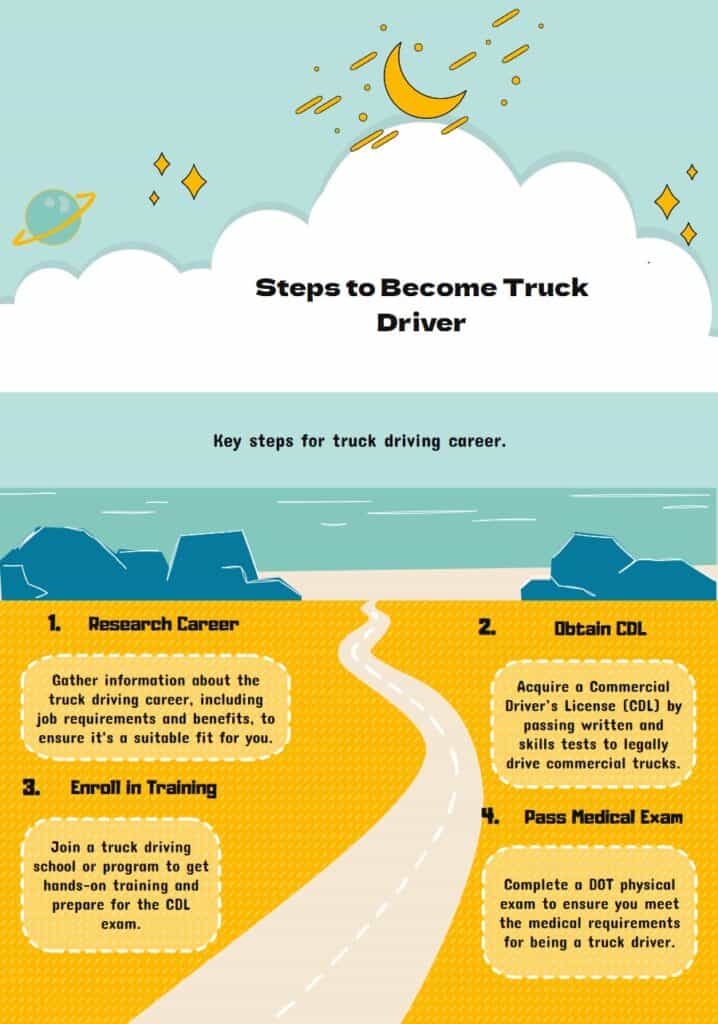Tired of your 9-to-5 grind? Ready to hit the open road and make some real dough? Learning how to become a truck driver might be your ticket to freedom and financial stability. The trucking industry is always on the lookout for skilled drivers, with over 3.5 million truck drivers currently employed in the U.S. 2 This guide will walk you through the seven key steps to kickstart your trucking career – from getting your CDL to landing your first gig.
Buckle up, future road warrior!
Key Takeaways
To become a truck driver, you need a regular driver’s license, Commercial Learner’s Permit (CLP), and Commercial Driver’s License (CDL). You must be 18 for in-state driving or 21 for interstate driving.
Truck drivers can earn an average of $25.52 per hour according to the U.S. Bureau of Labor Statistics. New drivers typically start at $30,000 to $40,000 per year.
There are over 3.5 million truck drivers employed in the U.S. They often drive 2,000 to 3,000 miles each week, sometimes spending days or weeks away from home.
Truck drivers can work as company employees, independent contractors, or owner-operators. Each option offers different levels of freedom and responsibility.
Many trucking companies offer paid CDL training programs lasting about 12 weeks. These programs teach essential skills and prepare drivers for their CDL tests.
Table of Contents
The Role of a Truck Driver

Truck drivers are the backbone of our nation’s supply chain. They haul goods across the country, keeping stores stocked and our economy moving.
Job Functions of a Truck Driver

Truck drivers do more than just drive. They’re the backbone of our nation’s supply chain. These road warriors haul goods across the country, often spending days or weeks away from home. 1 But their job isn’t just about keeping the wheels turning. They inspect their rigs before each trip, making sure everything’s ship-shape. Safety first, always.
Once on the road, drivers must follow traffic laws and keep a keen eye on their cargo. They’re not just moving stuff from A to B – they’re guardians of valuable freight. 2 At journey’s end, there’s paperwork to tackle.
Yep, even truckers can’t escape the pen-pushing part of the job. It’s all part of the gig… making sure goods get where they need to go, safe and sound.
Typical Work Environments for Truck Drivers

Truck drivers spend most of their time on the road. They cover 2,000 to 3,000 miles each week, often driving at night and on weekends. Their “office” is the cab of a big rig, with highways and interstates as their workplace.
But it’s not all open road. Drivers also visit truck terminals, warehouses, and rest areas. These spots offer a chance to stretch, grab a meal, or catch some shut-eye. 3
Work schedules for truckers vary widely. Some trips last just two nights, while others can stretch for weeks. Drivers rely on truck stops and highway rest areas for basic needs. These places provide showers, food, and a spot to park and sleep.
It’s a unique lifestyle that mixes freedom with long hours away from home. Truckers must be ready for anything – from bad weather to traffic jams – as they keep goods moving across the country. 4
Steps to Become a Truck Driver

Ready to hit the open road? Becoming a truck driver isn’t just about hopping in a big rig. It’s a journey with clear steps – from getting your regular license to snagging that coveted CDL.
Let’s break down the path to your new career….
Initial Requirements

Buckle up, future truckers! Before you hit the open road, you’ve got to meet some basic rules. First off, age matters. If you want to drive within your state, you need to be 18. But for those long hauls across state lines? You’ve gotta be 21. 5 No faking it here – you’ll need proof that you’re a U.S. citizen. And don’t even think about getting behind the wheel without a valid driver’s license. Oh, and a clean driving record? That’s like gold in this biz.
Want to get a head start? Consider signing up for CDL driver training. It’s not just about learning to drive big rigs.
These programs teach you the ins and outs of the trucking world. Plus, they give you that crucial experience employers love. 6 Speaking of experience, let’s talk about how to build yours and secure that all-important Commercial Driver’s License.
Getting a Regular Driver’s License

Getting a regular driver’s license is step one on your road to trucking. You’ll need a clean driving record to start. 5 Most states require you to be at least 16 years old. You’ll take a written test on road rules and signs.
Then, you’ll show off your driving skills during a road test.
Don’t sweat it if you fail the first time. Many folks do. Just keep practicing and try again. Once you pass, you’ll get your license. This plastic card is your ticket to the open road. 7 It’s also your first step to becoming a pro trucker. Remember, safe driving now sets you up for success later.
A regular license is like learning to crawl before you walk. It’s the foundation for your trucking career. – Anonymous Trucker
Obtaining a Commercial Learner’s Permit (CLP)

Now that you’ve got your regular driver’s license, it’s time to level up. The next step? Snagging your Commercial Learner’s Permit (CLP). This bad boy is your ticket to the big leagues of trucking.
First things first, grab your state’s CDL manual and hit the books. You’ll need to score at least 80% on the CLP exam – no sweat, right? But here’s the kicker: your CLP is only good for 180 days.
So don’t drag your feet! 8

Before you can even think about taking the test, you’ll need some paperwork. Proof of Social Security, citizenship, and a clean driving record are must-haves. Oh, and don’t forget that Medical Exam Certificate – it’s like a physical for your career.
Once you’ve got all your ducks in a row, you can take the plunge. But hold your horses! You’ll need to wait at least 14 days after getting your CLP before you can go for the full CDL.
It’s a waiting game, but trust me, it’s worth it. 9
Building Driving Experience

After getting your CLP, it’s time to hit the road… safely. Building driving experience is key to becoming a pro trucker. Most folks start with a truck driving school. These programs usually last about 12 weeks. 5 You’ll learn from seasoned drivers who know their stuff.
During training, you’ll practice on different types of trucks. You might start with delivery trucks and work up to semi-trucks. You’ll learn how to handle flatbeds, tankers, and even oversized loads.
Some states, like Arizona and Nevada, have more job growth for truckers. 10 So, you might want to focus your training there. The more miles you log, the better driver you’ll become.
Securing a Commercial Driver’s License (CDL)
Getting a CDL is a big step in your truck driving journey. You’ll need to pass both written and skills tests. The written test covers traffic laws, safe driving, and cargo handling.
For the skills test, you’ll show off your driving chops with a pre-trip inspection, basic control, and on-road driving. 12
The open road is calling – answer it with a CDL in hand!
Each state has its own rules for CDLs. Some give you the license right away, while others take a week or two. You must be at least 18 for in-state driving, or 21 for crossing state lines.
Don’t forget to pass your DOT physical exam too. It’s a lot to tackle, but with hard work, you’ll be hitting the highway in no time. 11
Acquiring Additional Endorsements
After getting your CDL, you can boost your job options. Extra endorsements open doors to more pay and varied work. These special add-ons let you haul different types of cargo. 7
Want to carry dangerous goods? Go for the H (Hazmat) endorsement. Like the idea of pulling multiple trailers? The T endorsement is for you. Hauling liquids more your style? Aim for the N (tanker) endorsement.
You can even mix and match – the X endorsement covers both Hazmat and tanker loads. Each one needs its own test, both written and on the road. It’s extra work, but it pays off. More skills mean more jobs and better pay.
Plus, you’ll stand out from other drivers. So why not give your career a turbo boost? 5
Career Opportunities for Truck Drivers

Ready to hit the open road? Truck driving offers more than just a job – it’s a lifestyle. From solo gigs to team driving, the options are as wide as the highways you’ll cruise.
Becoming an Owner-operator
Becoming an owner-operator puts you in the driver’s seat of your career. You’ll have the freedom to pick jobs and set your own rates. 14 But it’s not all smooth roads ahead. You’ll need to juggle driving with running a business.
This means dealing with legal stuff, keeping your truck in top shape, and getting insurance. 13
The open road is calling, and I’m the boss of my own rig.
There are two main ways to be an owner-operator. You can get your own authority and run solo. Or you can lease your truck to a bigger company. Both have pros and cons. It’s a big step, but for many drivers, it’s worth the ride.
Next up, let’s look at working as an independent contractor.
Working as an Independent Contractor
Independent contractors in trucking have it good. They make their own decisions and work with various companies. 16 No one’s constantly looking over their shoulder! These drivers handle their own insurance and have more freedom.
It’s like running your own business on the road.
But it’s not always easy. Independent truckers need to find their own jobs and manage their finances. They have to keep up with safety regulations and maintain their truck. Still, for those who value independence and love the highway, it’s a career worth considering.
Just keep in mind, more freedom means more responsibilities… and paperwork! 15
Employment with Trucking Companies
Trucking companies offer steady jobs for drivers. They handle the business side, so you can focus on driving. Many firms provide good pay and perks due to driver shortages. 17 You might get sign-on bonuses or other rewards when you join.
Some even cover fuel costs and truck upkeep.
Working for a company means set routes and schedules. You’ll haul various loads across the country. It’s a great way to see America while earning a paycheck. Plus, you’ll gain experience that could lead to better gigs down the road. 3 Just make sure to pick a company that fits your needs and goals.
Training and Certification for Truck Drivers

Truck drivers need proper training and certification. It’s not just about driving big rigs. You’ll learn safety rules, how to handle loads, and more. Want to hit the open road? Keep reading!
CDL Requirements
Getting a Commercial Driver’s License (CDL) is key to becoming a truck driver. Let’s dive into what you need to do to get your CDL.
- Age requirement: You must be at least 18 years old for in-state driving and 21 for interstate driving.
- Valid regular driver’s license: You need a clean driving record with no major violations.19
- Commercial Learner’s Permit (CLP): Pass written tests on road signs, traffic laws, and safe driving practices.
- Medical exam: Get a DOT physical to prove you’re fit to drive big rigs.
- Entry Level Driver Training (ELDT): Complete coursework and skills tests set by the FMCSA.18
- CDL class choice: Pick Class A, B, or C based on the type of truck you want to drive.
- State knowledge tests: Pass exams on truck-specific laws and safety rules.
- Skills test: Show you can handle a big rig in real-world conditions.
- Background check: Pass a review of your driving and criminal history.
- Drug test: Prove you’re clean and ready to hit the road safely.
Once you’ve got your CDL, you’re ready to start your trucking career. Next up, let’s look at the different job options for truck drivers.
Training Programs for Truck Drivers
Truck driver training programs are crucial for aspiring truckers. These programs teach essential skills and prepare drivers for their CDL tests.
- Paid CDL Training: Many trucking companies offer paid training programs. These last about 12 weeks and cover all aspects of truck driving. You’ll learn how to handle big rigs and stay safe on the road.
- Swift Transportation Programs: Swift offers various training options for new drivers. Their programs mix classroom learning with hands-on practice. You’ll get to know the ins and outs of truck driving from pros.
- Private Truck Driving Schools: These schools offer comprehensive training. They teach you everything from basic driving skills to complex maneuvers. Most programs run for 4 to 6 weeks.
- Community College Programs: Some community colleges have truck driving courses. These programs often cost less than private schools. They usually take about 8 weeks to complete.
- Online CDL Training: Some parts of CDL training can be done online. This option is great for folks who need flexible schedules. But you’ll still need hands-on practice to get your license.
- Military Veterans Programs: Many companies offer special training for vets. These programs often provide extra support and job placement help. They’re a great way for vets to start a new career.
- Apprenticeship Programs: Some companies offer on-the-job training. You’ll work and learn at the same time. These programs can last up to a year but offer valuable experience.
Now, let’s shift gears and look at the job search strategies for truck drivers.
Employment Process for Truck Drivers

Ready to hit the road? The job hunt for truck drivers is a mix of old-school networking and modern tech. From polishing your resume to acing interviews, there’s a lot to cover… but don’t worry, we’ve got your back! Keep reading to learn the ins and outs of landing your dream trucking gig.
Job Search Strategies
Looking for a truck driving job? Start with industry websites and job boards. They’re packed with openings. 22 Don’t forget to network at truck shows and online forums. These spots are gold mines for job leads.
Join groups like the American Trucking Associations. They often know about jobs before they’re posted. 23
Your next gig might be just a click away. Many trucking companies post jobs on LinkedIn and Facebook.
Keep your profiles up-to-date and professional. It’s also smart to reach out to dispatchers directly. They often have the inside scoop on upcoming routes. Now, let’s talk about joining a finishing program…
Joining a Finishing Program
Finishing programs are a big deal for new truck drivers. Some trucking firms want fresh CDL holders to join these programs. They usually last about a month. 24 During this time, you’ll get comfy with big rigs and learn the ropes of the job.
It’s hands-on training that puts you in the driver’s seat… literally!
These programs aren’t just about driving. You’ll also learn about the gear you’ll use daily. Plus, many driving schools help you find a job after you finish. 5 It’s like having a personal job hunter on your side.
Next up, let’s talk about how much you can earn as a truck driver.
Compensation for Truck Drivers

Truck drivers can earn a pretty penny – from mileage pay to bonuses. Wanna know how much you could rake in? Keep reading!
Payment Structures
Truck drivers can earn cash in different ways. Some get paid by the hour, while others make money for each mile they drive. Companies might also offer a good salary.
I once worked for a firm that paid per mile – it felt great to see my earnings grow with every state line I crossed! Owner-operators have a cool deal too. They often get a cut of the freight money, which can lead to bigger paychecks. 25
There’s more to trucker pay than just the basics. Drivers can score extra bucks through things like accessorial charges and detention pay. These are fancy terms for getting paid to wait or do extra tasks.
Per diem cash helps cover food and lodging on the road. The main ways truckers get paid are cents per mile (CPM), a share of the load’s value, or extra fees for special jobs. It’s a mixed bag, but that’s what keeps the job interesting! 26
Industry Salary Averages
Moving from payment structures, let’s talk cash. Truck drivers’ pay can vary a lot. The U.S. Bureau of Labor Statistics says the average hourly wage is $25.52. That’s not bad, right? But wait, there’s more.
PayScale reports a slightly lower average at $21.98 per hour. New drivers usually start between $30,000 to $40,000 a year. 28
Here’s the cool part – your paycheck can grow. As you gain experience or pick up special skills, you can earn more. Some drivers make big bucks hauling hazardous materials or driving oversized loads.
Others boost their income by becoming owner-operators. The road to higher pay is there if you’re willing to put in the miles and learn new tricks of the trade. 27
People Also Ask
What’s the first step to becoming a truck driver?
Start by getting your high school diploma or GED. Then, head to your local Department of Motor Vehicles or Texas Department of Public Safety to snag a commercial driver’s license (CDL) handbook. It’s your roadmap to success!
Do I need special training to drive those big rigs?
You bet! You’ll need to attend a trucking school to learn the ropes of handling tractor-trailers and other heavy vehicles. It’s not just about driving – you’ll learn about logistics, safety rules, and even how to handle those tricky truckstops.
What kind of tests do I need to pass?
Buckle up for a few tests! You’ll face a written exam, skills test, and road test. Don’t forget the medical examination – the Federal Motor Carrier Safety Administration wants to make sure you’re fit as a fiddle to hit the road.
Are there any deal-breakers that could keep me from becoming a truck driver?
Yep, a few speed bumps could slow you down. Trucking companies often do background checks. DUIs or a history of substance abuse might put the brakes on your career. Keep your nose clean, and you’ll be good to go!
What’s the job market like for truck drivers?
It’s revving up! With online shopping booming, the need for commercial truck drivers is sky-high. From hauling construction materials in dump trucks to delivering goods across states, there’s plenty of work to go around.
What perks come with the job?
Trucking gigs often come with a nice package. We’re talking competitive salaries, health insurance, and sometimes even retirement plans. Plus, you get to see the country from your office on wheels. Just remember, life on the road means managing expenses and staying connected via the internet at times.
References
^ https://skillpointe.com/careers/transportation/truck-driver
^ https://www.careerexplorer.com/careers/truck-driver/
^ https://www.ncbi.nlm.nih.gov/pmc/articles/PMC8924679/
^ https://www.iowacentral.edu/transportation/work_environment.asp
^ https://truckstop.com/blog/become-truck-driver/ (2023-08-17)
^ https://www.indeed.com/career-advice/career-development/how-to-become-truck-driver (2023-10-10)
^ https://www.hmdtrucking.com/blog/how-to-become-a-truck-driver/
^ https://www.acvauctions.com/blog/what-is-commercial-learners-permit
^ https://www.fmcsa.dot.gov/registration/commercial-drivers-license/how-do-i-get-commercial-drivers-license (2022-02-10)
^ https://www.learnhowtobecome.org/truck-driver/
^ https://www.dmv.ca.gov/portal/driver-education-and-safety/special-interest-driver-guides/truck-drivers/
^ https://schneiderjobs.com/blog/how-to-get-cdl
^ https://img.overdriveonline.com/files/base/randallreilly/all/migrated-files/ovd/2018/10/PIB19_DMT_RFS-2018-10-11-13-47.pdf (2018-10-11)
^ https://www.foleyservices.com/articles/become-owner-operator
^ https://www.intermodal.org/documents/Independent_Contractor_White_Paper_Feb_2024.pdf
^ https://www.indeed.com/career-advice/finding-a-job/truck-drivers-independent-contractors
^ https://www.linkedin.com/pulse/truckers-future-work-jeff-wald
^ https://cdlschool.com/cdl-faq/how-to-become-a-truck-driver
^ https://mountainriver.com/tips/truck-driver-requirements-training-career/
^ https://www.swifttrans.com/blog/supplemental-training-programs-for-truck-drivers (2024-01-26)
^ https://www.swifttrans.com/truck-driving-school
^ https://www.researchgate.net/publication/288895764_Truck_driver_recruitment_Some_workable_strategies (2016-09-28)
^ https://www.driverreach.com/blog/the-essential-guide-to-truck-driver-recruitment-strategies-challenges-and-best-practices (2022-10-26)
^ https://driverresourcecenter.com/the-ultimate-guide-to-becoming-a-truck-driver/
^ https://blog.drive4ats.com/truck-drivers-pay-structure
^ https://blog.drive4ats.com/video/7-truck-driver-pay-structures
^ https://www.cloudtrucks.com/blog-post/highest-paying-trucking-salaries (2024-03-20)
^ https://migway.com/blog/how-much-money-do-truck-drivers-make/ (2024-08-15)

